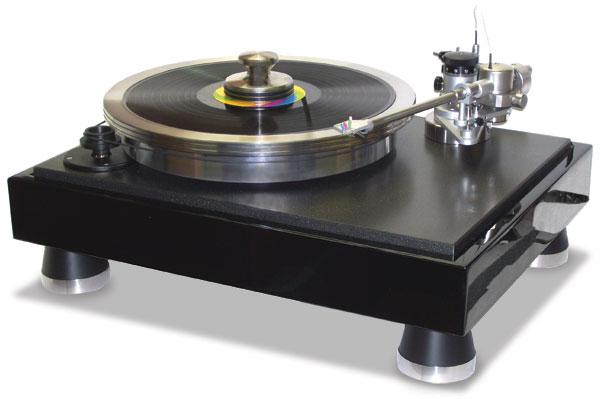Michael, I know it's apples versus oranges, but that's real life after all. Having now auditioned both the JC-3 and the Manley Chinook, how would you constrast the two? I'm not asking you to tell which one is better, just help me to understand how they are different. If context helps, I have a VPI Classic 3 with Te Kaitora Rua and listen to jazz with some classic rock and indie thrown in. Classical when in a mood. Favorite albums include (the Tone Float) In Absentia, Jazz at the Pawnshop, Into the Labyrinth. Looking to upgrade the phono stage of my Perseus Magnum ... intrigued by staying tubey but addicted to macrodynamics.
Parasound Halo JC 3 phono preamplifier Measurements
- Read more about Parasound Halo JC 3 phono preamplifier Measurements
- Log in or register to post comments
Parasound Halo JC 3 phono preamplifier Specifications
- Read more about Parasound Halo JC 3 phono preamplifier Specifications
- Log in or register to post comments

Michael, I know it's apples versus oranges, but that's real life after all. Having now auditioned both the JC-3 and the Manley Chinook, how would you constrast the two? I'm not asking you to tell which one is better, just help me to understand how they are different. If context helps, I have a VPI Classic 3 with Te Kaitora Rua and listen to jazz with some classic rock and indie thrown in. Classical when in a mood. Favorite albums include (the Tone Float) In Absentia, Jazz at the Pawnshop, Into the Labyrinth. Looking to upgrade the phono stage of my Perseus Magnum ... intrigued by staying tubey but addicted to macrodynamics.
Pages
Parasound Halo JC 3 phono preamplifier
- Read more about Parasound Halo JC 3 phono preamplifier
- 1 comment
- Log in or register to post comments
VPI Classic 3 turntable & Classic-JMW tonearm Associated Equipment

It’s always helpful to give credit where credit is due and since there were no comments on this VPI Classic review, I thought I’d add one…..or two …. or so very brief comments.
Turntable: Using the same stereo system for all tests my friend and I tried the VPI Classic 3 against a Clearaudio Innovation (XV-1s/1t), Brinkmann Bardo (Lyra Titan), and a couple other turntables and it really held its’ own. The Classic 3 has great pitch stability and a lively presentation that is rather addictive, making it quite the bargain compared to this stiff competition.
Tonearm: Using the 10.5i unipivot arm we tried a Soundsmith Zephyr and Dynavector 17D3, each around $1k, and the 17D3 was the hands down favorite with a greater amount of detail, dynamics, larger soundstage, and wider frequency range. Moving up to the $5k range with the Benz Micro LP S-MR and Dynavector XV-1s, the Dyna was again the favorite primarily due to the unrestrained dynamics, clear separation around each instrument (wow!), and wonderful musicality.
Options: In the Classic 1 the stainless steel arm tube and Nordost Valhalla wiring options will bring it up to near Classic 3 status, without the on-the-fly adjustable VTA, and are both highly recommended if looking towards the less expensive Classic 1 vs. the more expensive 2/3/4 models. With that said, the center weight and outer edge ring are must haves since they really lock down the soundstage – try it, the difference is pretty amazing. What about the SDS to better control the speed? Using a strobe the VPI is awfully close to dead-on, so the SDS seems more of a like to have than need to have.
We were both surprised the Benz LP S-MR didn’t do as well as the Dyna XV-1s given the recent reviews we’ve read (we each bought an XV-1s after listening), but it really highlights the need to listen and trust your own ears. (At least we can say the Classic/17D3 and Classic/XV-1s sound like great synergistic matches to us.) I suspect the tonearm/cartridge interaction was the key deciding factor here, but maybe the kind Mr. Fremer can shed some light on tonearm/cartridge matching?

It can be said that this is a product that is quite suitable for among us, especially for those who are in-depth and experienced and are willing to invest both time and money to optimize performance.
Pages
VPI Classic 3 turntable & Classic-JMW tonearm Specifications

It’s always helpful to give credit where credit is due and since there were no comments on this VPI Classic review, I thought I’d add one…..or two …. or so very brief comments.
Turntable: Using the same stereo system for all tests my friend and I tried the VPI Classic 3 against a Clearaudio Innovation (XV-1s/1t), Brinkmann Bardo (Lyra Titan), and a couple other turntables and it really held its’ own. The Classic 3 has great pitch stability and a lively presentation that is rather addictive, making it quite the bargain compared to this stiff competition.
Tonearm: Using the 10.5i unipivot arm we tried a Soundsmith Zephyr and Dynavector 17D3, each around $1k, and the 17D3 was the hands down favorite with a greater amount of detail, dynamics, larger soundstage, and wider frequency range. Moving up to the $5k range with the Benz Micro LP S-MR and Dynavector XV-1s, the Dyna was again the favorite primarily due to the unrestrained dynamics, clear separation around each instrument (wow!), and wonderful musicality.
Options: In the Classic 1 the stainless steel arm tube and Nordost Valhalla wiring options will bring it up to near Classic 3 status, without the on-the-fly adjustable VTA, and are both highly recommended if looking towards the less expensive Classic 1 vs. the more expensive 2/3/4 models. With that said, the center weight and outer edge ring are must haves since they really lock down the soundstage – try it, the difference is pretty amazing. What about the SDS to better control the speed? Using a strobe the VPI is awfully close to dead-on, so the SDS seems more of a like to have than need to have.
We were both surprised the Benz LP S-MR didn’t do as well as the Dyna XV-1s given the recent reviews we’ve read (we each bought an XV-1s after listening), but it really highlights the need to listen and trust your own ears. (At least we can say the Classic/17D3 and Classic/XV-1s sound like great synergistic matches to us.) I suspect the tonearm/cartridge interaction was the key deciding factor here, but maybe the kind Mr. Fremer can shed some light on tonearm/cartridge matching?

It can be said that this is a product that is quite suitable for among us, especially for those who are in-depth and experienced and are willing to invest both time and money to optimize performance.
Pages
VPI Classic 3 turntable & Classic-JMW tonearm Page 2
- Read more about VPI Classic 3 turntable & Classic-JMW tonearm Page 2
- Log in or register to post comments

It’s always helpful to give credit where credit is due and since there were no comments on this VPI Classic review, I thought I’d add one…..or two …. or so very brief comments.
Turntable: Using the same stereo system for all tests my friend and I tried the VPI Classic 3 against a Clearaudio Innovation (XV-1s/1t), Brinkmann Bardo (Lyra Titan), and a couple other turntables and it really held its’ own. The Classic 3 has great pitch stability and a lively presentation that is rather addictive, making it quite the bargain compared to this stiff competition.
Tonearm: Using the 10.5i unipivot arm we tried a Soundsmith Zephyr and Dynavector 17D3, each around $1k, and the 17D3 was the hands down favorite with a greater amount of detail, dynamics, larger soundstage, and wider frequency range. Moving up to the $5k range with the Benz Micro LP S-MR and Dynavector XV-1s, the Dyna was again the favorite primarily due to the unrestrained dynamics, clear separation around each instrument (wow!), and wonderful musicality.
Options: In the Classic 1 the stainless steel arm tube and Nordost Valhalla wiring options will bring it up to near Classic 3 status, without the on-the-fly adjustable VTA, and are both highly recommended if looking towards the less expensive Classic 1 vs. the more expensive 2/3/4 models. With that said, the center weight and outer edge ring are must haves since they really lock down the soundstage – try it, the difference is pretty amazing. What about the SDS to better control the speed? Using a strobe the VPI is awfully close to dead-on, so the SDS seems more of a like to have than need to have.
We were both surprised the Benz LP S-MR didn’t do as well as the Dyna XV-1s given the recent reviews we’ve read (we each bought an XV-1s after listening), but it really highlights the need to listen and trust your own ears. (At least we can say the Classic/17D3 and Classic/XV-1s sound like great synergistic matches to us.) I suspect the tonearm/cartridge interaction was the key deciding factor here, but maybe the kind Mr. Fremer can shed some light on tonearm/cartridge matching?

It can be said that this is a product that is quite suitable for among us, especially for those who are in-depth and experienced and are willing to invest both time and money to optimize performance.
Pages
VPI Classic 3 turntable & Classic-JMW tonearm
- Read more about VPI Classic 3 turntable & Classic-JMW tonearm
- 2 comments
- Log in or register to post comments
Musicangle.com Welcomes Randy Wells!
- Read more about Musicangle.com Welcomes Randy Wells!
- Log in or register to post comments
Kuzma 4Point tonearm Specifications
- Read more about Kuzma 4Point tonearm Specifications
- Log in or register to post comments


I noticed that in your review of the Kuzma 4Point 9 in the current issue of Stereophile (June 2018 issue) that you make mention of the fact that this new arm is more compatible with the Linn LP12 platform. Unfortunately, this is reported to actually NOT be the case! There are several users in Europe who have tried this combo, all have been severely disappointed! The suspension of the Linn requires a very light weight arm...along with cabling that has no way of interfering with the subchassis and bounce. As a current LinnLP12 Radikal D owner, I know this as a fact. The LP12 is VERY unforgiving when it comes to arms and the compatibility with weight, design etc. Did you happen to check the new Kuzma 4point 9 on a LP12 table?
Pages
Kuzma 4Point tonearm Associated Equipment
- Read more about Kuzma 4Point tonearm Associated Equipment
- Log in or register to post comments


I noticed that in your review of the Kuzma 4Point 9 in the current issue of Stereophile (June 2018 issue) that you make mention of the fact that this new arm is more compatible with the Linn LP12 platform. Unfortunately, this is reported to actually NOT be the case! There are several users in Europe who have tried this combo, all have been severely disappointed! The suspension of the Linn requires a very light weight arm...along with cabling that has no way of interfering with the subchassis and bounce. As a current LinnLP12 Radikal D owner, I know this as a fact. The LP12 is VERY unforgiving when it comes to arms and the compatibility with weight, design etc. Did you happen to check the new Kuzma 4point 9 on a LP12 table?



